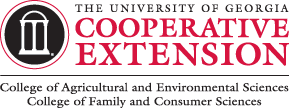Thrips are consistent and predictable insect pests of seedling cotton in Georgia. Thrips infest cotton at emergence and initially feed on the lower surface of cotyledons prior to feeding in the terminal bud of developing seedlings. Excessive thrips feeding results in crinkled malformed true leaves, stunted plants, delayed maturity, reduced yield potential, and in severe cases loss of apical dominance and stand loss. Cotton seedlings are most susceptible to thrips during early stages of development (cotyledon thru 2- leaf). Once seedlings reach the 4-leaf stage and are growing rapidly thrips are rarely an economic concern.
Preventive insecticide treatments at planting are used by most growers for early season thrips control. The most common preventive treatments include the systemic insecticides imidacloprid or thiamethoxam applied as a commercial seed treatment. Additional options for early season thrips control include acephate or imidacloprid applied as an in-furrow spray. Both imidacloprid and thiamethoxam are neonicotinoid insecticides and performance in Georgia has historically been similar when used as a seed treatment for thrips control; thus we will refer to these commonly used treatments collectively as neonicotinoid seed treatments (NST). NSTs are active on thrips for about 21 days after planting (DAP); however, supplemental foliar sprays are needed in some environments (high thrips populations and/or extended infestations).
There are two cultural practices which have a significant impact on expected thrips populations: 1) planting date and 2) tillage practice. Thrips infestations are typically higher on cotton planted during April and early May compared with late May and June plantings. Thrips infestations are also significantly greater in conventional tillage systems compared with reduced tillage systems. A risk index of thrips infestations may be predicted for cotton planted based on these two cultural practices, planting date and tillage practice. Cotton planted in April or early May in a conventional tillage system would be considered “High Risk” for thrips. Whereas cotton planted after mid-May and/or in a reduced tillage system would be considered “Low Risk” for thrips.
Data was summarized from small plot trials conducted by UGA which included a NST with and without a foliar insecticide spray at the 1-leaf stage. In total 23 trials conducted from 2001 to 2013 were included in the data summary. Individual trials were assembled into “Risk Groups” based on planting date and tillage practice. Trials which were planted prior to May 10 in a conventional tillage system were placed in the high thrips risk group. Whereas trials planted after May 10 and/or in a reduced tillage system were placed in the low thrips risk group. Trial yields from the NST alone and the NST+foliar 1-leaf treatment were compared in each risk group using a paired t-test.
Sixteen trials were placed in the high thrips risk group and seven trials were placed in the low thrips risk group. The yield response associated with using a NST compared with no insecticide (NST minus no insecticide) is illustrated in Figure 1. Yields were numerically increased in 22 of 23 trials with an average yield increase of 251 lbs. lint per acre when a NST was used compared with no insecticide plots. Yield responses tended to be greater in trials conducted in high risk environments. On average yields were 308 and 121 lbs. lint/acre higher when compared with no insecticide plots in high and low risk environments respectively. This consistent yield response to NSTs is why most growers use preventive insecticides at planting for thrips control.
Foliar insecticide (generally acephate at 0.18 lb ai/acre) was applied at the 1-leaf stage. On average the foliar insecticide was applied at 16 DAP with a range of 13-20 DAP. Figure 2 illustrates mean yield for no insecticide, NST, and NST+foliar 1-leaf in the low risk and high risk groups. Yields were not statistically different (prob (t) = 0.6043) for NSTs with and without a supplemental foliar spray in the low risk environment, 1335 and 1348 lbs. lint/acre respectively. Whereas, the NST+foliar 1-leaf treatment had significantly (prob (t) = 0.0122) higher yields compared with the NST alone in the high risk environment, 1526 and 1457 lbs. lint/acre respectively.
In summary, commercial seed treatments including imidacloprid or thiamethoxam provide similar levels of thrips control and are active on thrips for about three weeks after planting. NSTs provide a consistent yield response in both low and high thrips risk environments. However, research and observation have shown that a supplemental foliar insecticide spray is often needed in addition to a NST when thrips infestations are high, i.e. high thrips risk environment. All cotton should be scouted on a regular basis for thrips and other insect pests, but we should expect higher thrips populations on cotton planted prior to May 10 in a conventionally tilled system compared with cotton planted after May 10 and/or in a reduced tillage system. Unless frequent and thorough scouting reveals thrips populations are below the threshold of 2-3 thrips per plant with immatures present, a foliar thrips systemic insecticide should be applied at the 1-leaf stage in conventional tilled fields planted prior to May 10 when a NST is used.
In most situations a NST plus a foliar insecticide at the 1-leaf stage provides good thrips control, but fields should be scouted regularly for thrips and injury following the foliar spray until seedlings reach the 4-leaf stage and are growing rapidly. In fields planted after May 10 or where reduced tillage is used, the risk of damaging thrips infestations is lower and an automatic foliar spray should not be applied when a NST is used. Fields in this low thrips risk environment should be scouted and treated in a timely manner when thresholds are exceeded.



